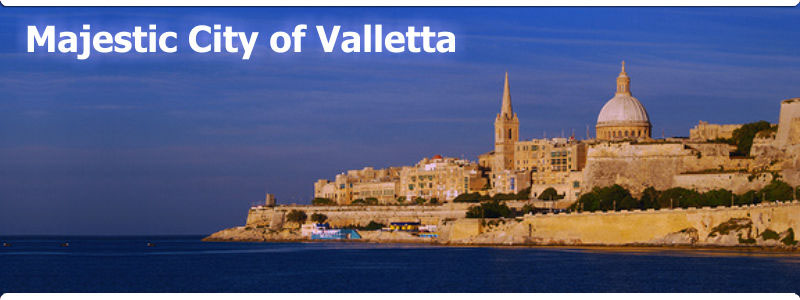| < Back to About Malta |
Casa Bernard, RabatSumptuously furnished with period furniture, this late 16th Century Palazzo has great character and is perfectly preserved, having been recently restored to its former splendour. The home of a Maltese noble family. still lived in today, offers guided tours daily, except Sundays & public holidays. Casa Rocca Piccola, VallettaCasa Rocca Piccola is still privately owned and is a much loved family home. Over the last few years a Museum of Costume has been added. World War II Air Raid Shelters have provided a dramatic and exciting addition to the tours of the house. All this has all been made possible from the contributions that come in from the thousands of tourists who come to Malta and Valletta every year. Fort Rinella, KalkaraFort Rinella, in Kalkara, was built in 1878. This fort is not only a unique remnant of Malta`s recent British colonial past,. Combining lively historical re-enactments with expert commentary this tour offers you a unique window into the past life of the late 19th century Victorian garrison in this coastal fort. Fort St Angelo, BirguOn their arrival in Malta in 1530, the Knights chose to settle in Birgu, and Fort St Angelo became the seat of the Grand Master`s military might. They made this their primary fortification and substantially reinforced and remodelled it, making it a formidable stronghold. Fort St Angelo bravely withstood the Ottoman Turks during the Great Siege of Malta, though in the aftermath of that siege the Knights built the fortified city of Valletta on Mount Sciberras across the other side of Grand Harbour. 
Grand Master`s Palace, VallettaDominating Palace Square, the Grand Master`s Palace has always been the house of government in Malta, presently hosting the President`s office. When parliament is not in session the palace can be visited free of charge. Within its walls is the famous Council Chamber, adorned with valuable Gobelins tapestries woven in France for Grand Master Ramón Perellos y Roccaf. The other rooms and passages of the palace are splendidly furnished with objects d`art, old coats of arms as well as armour. Particularly notable are the former Hall of the Supreme Council of the Knights, which hosts fine frescoes and the Hall of the Ambassadors, where portraits of Grand Masters and European rulers can be found. Manoel Theatre, VallettaThe 300-year-old Manoel Theatre is a compact, bustling six-hundred and twenty-three seat venue, with a lavish, oval-shaped auditorium, three tiers of boxes constructed entirely of wood and decorated with 22- carat gold leaf. Hidden behind an austere facade that is fully in keeping with Valletta`s Mannerist architecture, is a richly adorned, glorious Rococo interior. Despite numerous alterations over the years, it retains many of its old architectural features, such as the white Carrara marble staircase, shell-shaped niches, and Viennese chandeliers. The Theatre has a very busy schedule and hosts musical anddramatic events throughout the year. National Library, VallettaThe idea of a public Library in Malta originated in 1555 with the issue of a decree by Fra` Claude de la Sengle, Grand Master of the Order of St. John, whereby all books in the legacy of deceased knights were to pass to the Common Treasury of the Order. It was not until 1776, however, that the formal foundation of a Bibliotheca Publica was decreed at the Chapter General of the Order convened by Grand Master Emmanuel de Rohan. Palazzo Falson, MdinaPalazzo Falson is a typical two-storey medieval palace fashioned on Sicilian examples of its period, and is one of the imposing Palazzi built by the Sicilian, Spanish and local nobility in Mdina. The Palazzo consists of a series of rooms encircling an internal courtyard, and an overlying piano-nobile which contained the original living quarters. Palazzo Parisio, NaxxarDescribed as "a miniature Versailles", Palazzo Parisio is a historic palace at the heart of the Maltese village of Naxxar, facing the baroque parish church dedicated to Our Lady in Victory Square. The interiors are rich with fine frescoes, magnificent marble, mirrored walls, trompes de l`oeil, rare paintings and extravagant gilding. The internationally recognised landscaped gardens, which are acclaimed as being among the finest in Europe, further reflect the splendour of this gracious home. Sacra Infermeria, VallettaThe Sacra Infermeria (Holy Infirmary) occupies a large site which overlooks the Grand Harbour, very near Fort St. Elmo. This hospital, one of the first buildings of Valletta, started to function in 1574 under Grand Master Jean de la Cassiere. St Agatha`s Catacombs, RabatThese Catacombs were not intended to be hiding places during persecutions of Christians, nor as living quarters. They were underground cemeteries consisting of long narrow corridors with tombs on each side and vaults. Some of the tombs are even decorated with reliefs and frescoes. Most of the tombs were used for the internment of two people. Sometimes a double tomb has a thin wall separating one from the other. At times they are put side by side, and not only two, but even three, four or five persons were buried in the same grave. |
| < Back to About Malta |
|
|














